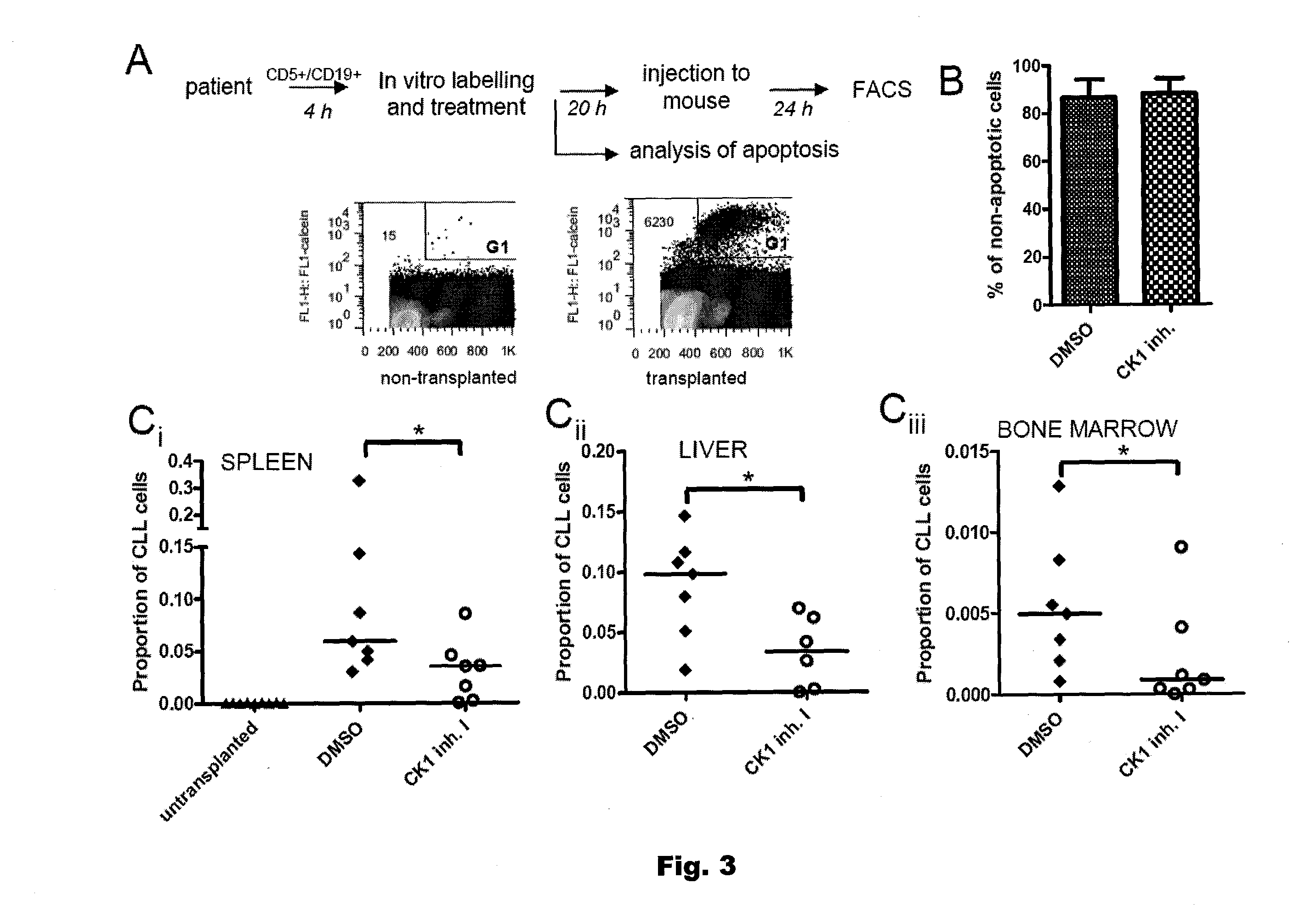Casein kinase 1 inhibitors for the treatment of b-cell chronic lymphocytic|leukemia
a technology of b-cell chronic lymphocytic leukemia and inhibitors, which is applied in the direction of plant growth regulators, biocide, animal husbandry, etc., can solve the problems of uncontrolled proliferation of tumor cells, reduced immune system function, and hypertrophy of organs, so as to prevent the migration of cll cells and efficiently inhibit the migration of leukemia cells
- Summary
- Abstract
- Description
- Claims
- Application Information
AI Technical Summary
Benefits of technology
Problems solved by technology
Method used
Image
Examples
example 1
Effect of CK1 Inhibitors to the Migration of CLL Cells
[0020]In this example, the MEC1 cell line was used, which is a well-defined cell line obtained from a CLL patient in a pro-lymphocytic transformation. The MEC1 line is used as a transplantation model of CLL. MEC1 were obtained from the DSMZ collection (Braunschweig, Germany) and they were cultivated in RPMI1640 supplemented with 10% FBS and antibiotics at 37 ° C. and 5% of CO2.
[0021]Into the upper insert of HTS Transwell® 96-well plates (Corning Incorporated, Mexico) with polycarbonate membranes with the pore size of 5.0 μm, 0.5×106 MEC1 cells were seeded. The cells were treated overnight with D4476 (CK1 inhibitor, 100 μM, Calbiochem, San Diego, Calif., USA) in DMSO, or PF670462 (CK1 inhibitor, 50 μM; Tocris Biosciences, Ellisville, Mo., USA) in DMSO, or DMSO (dimethyl sulfoxide; control—solvent of the inhibitors above, used in the same amount as in the experimental wells), and incubated in the complete medium (including 10% FCS)...
example 2
Effect of a CK1 Inhibitor on the Chemokine-Controlled Transendothelial Invasion of CLL Cells
[0025]In the complex environment of the human body, cells react to the attractants and have to pass through extra-cellular matrix or endothelial barrier, which is a process known as invasion. It was tested whether the CK1 inhibitors affect the invasion through a layer of human umbilical vein endothelial cell (HUVEC).
[0026]Into the upper insert of HTS Transwell® 96-well plates (Corning Incorporated, Mexico) with polycarbonate membranes with the pore size of 5.0 μm, covered with HUVEC (human umbilical vein endothelial cells monolayer), 0.5×106 MEC1 cells were seeded. The cells were treated overnight with D4476 (CK1 inhibitor, 100 μM, Calbiochem, San Diego, Calif., USA) in DMSO, or PF670462 (CK1 inhibitor, 50 Tocris Biosciences, Ellisville, Mo., USA) in DMSO, or DMSO (dimethyl sulfoxide; control—solvent of the inhibitors above, used in the same amount as in the experimental wells), and incubated...
example 3
Inhibition of Migration of CLL Cells in Tissues in Vivo by CK1 Inhibitors
[0028]NOD SCID IL2R gamma null (NSG) mice obtained from The Jackson Laboratory (Bar Harbor, Me., USA) were held in special pathogen-free conditions. These mice lack adult T-cells, B-cells and functional NK-cells. Non-irradiated mice (at the age of 8 to 16 weeks) were used for transplantation; the experiments were performed in accordance with legal provisions of the Czech Republic.
[0029]Primary B-cells from untreated patients with CLL were separated by gradient centrifugation followed by depletion of non-B-cells (RosetteSep® B Cell Enrichment Kit and Human CD3+ Depletion Kit; StemCell Technologies, Vancouver, Canada; or MACS B cell Isolation Kit II; Miltenyi Biotec, Bergisch Gladbach, Germany) according to the manufacturer's instructions. Evaluation of the expression profile of CD5 and CD19 of purified cells was performed using flow cytometry (three-color panel: CD45-TRI-COLOR, MHCD45065, Invitrogen, CD5-FITC, A...
PUM
| Property | Measurement | Unit |
|---|---|---|
| pore size | aaaaa | aaaaa |
| membrane potential | aaaaa | aaaaa |
| purity | aaaaa | aaaaa |
Abstract
Description
Claims
Application Information
 Login to View More
Login to View More - R&D
- Intellectual Property
- Life Sciences
- Materials
- Tech Scout
- Unparalleled Data Quality
- Higher Quality Content
- 60% Fewer Hallucinations
Browse by: Latest US Patents, China's latest patents, Technical Efficacy Thesaurus, Application Domain, Technology Topic, Popular Technical Reports.
© 2025 PatSnap. All rights reserved.Legal|Privacy policy|Modern Slavery Act Transparency Statement|Sitemap|About US| Contact US: help@patsnap.com



